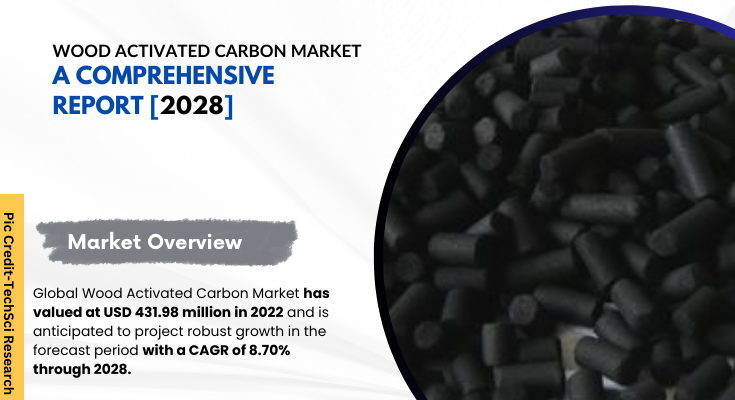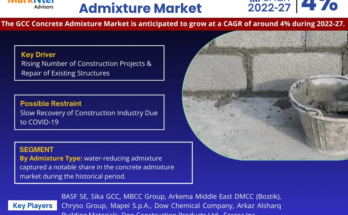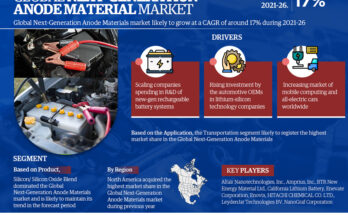According to TechSci Research report, “Wood Activated Carbon Market – Global Industry Size, Share, Trends, Competition Forecast & Opportunities, 2028”, the Global Wood Activated Carbon Market has valued at USD 431.98 million in 2022 and is anticipated to project robust growth in the forecast period with a CAGR of 8.70% through 2028. Technological advancements have played a pivotal role in driving the growth of the Global Wood Activated Carbon Market.
Wood activated carbon, derived from various wood sources, has long been valued for its adsorption capabilities, but recent innovations have not only improved its performance but also expanded its applications across diverse industries. One of the key technological advancements in wood activated carbon production has been the refinement of manufacturing processes. Traditional methods involved the activation of wood through physical or chemical means, but modern techniques have introduced more efficient and controlled processes.
The utilization of advanced pyrolysis techniques, like fluidized bed and microwave-assisted pyrolysis, has allowed for greater control over the activation process, resulting in higher pore volume and surface area. These innovations have significantly enhanced the adsorption capacity of wood activated carbon, making it more effective in capturing impurities from various mediums. Furthermore, the development of tailor-made wood activated carbon materials has been instrumental in broadening its applications. Researchers and manufacturers have focused on customizing the characteristics of wood-based activated carbon, such as pore size distribution and surface functional groups.
These tailored materials are designed to address specific adsorption needs in industries like water treatment, air purification, and the removal of contaminants from gases and liquids.
In the realm of water treatment, technological advancements have led to the creation of wood activated carbon products with a remarkable ability to remove a wide range of pollutants. These include not only common impurities like organic matter, chlorine, and heavy metals but also emerging contaminants like pharmaceuticals and personal care products. The development of wood activated carbon composites and hybrids, incorporating other materials like zeolites or graphene, has further improved its adsorption capacity and selectivity, making it an indispensable tool in the global quest for clean and safe drinking water.
In the field of air purification, technological advancements have resulted in wood activated carbon products capable of efficiently capturing volatile organic compounds (VOCs), odorous gases, and airborne pollutants. The incorporation of advanced activation techniques, such as steam activation, has led to activated carbon with superior adsorption kinetics, ensuring rapid removal of contaminants from indoor and outdoor air.
These innovations have found applications not only in industrial settings but also in residential and commercial air purifiers, contributing to improved indoor air quality. Moreover, advancements in quality control and testing methodologies have ensured that wood activated carbon products meet stringent performance standards. Innovations in analytical techniques, such as surface area analysis using gas adsorption methods and the use of cutting-edge equipment like scanning electron microscopes, have enabled manufacturers to precisely characterize their products.
This ensures that wood activated carbon consistently delivers the specified performance, reliability, and purity, which are crucial factors for its acceptance in critical applications like pharmaceutical manufacturing and food and beverage processing. Additionally, the adoption of digital technologies and automation in manufacturing processes has streamlined production, increased efficiency, and reduced waste in the wood activated carbon industry. Automation ensures greater consistency in product quality, minimizing variations and defects. Moreover, digital monitoring and control systems allow manufacturers to optimize resource utilization, resulting in cost savings and reduced environmental impact.
In recent years, sustainability has become a focal point in the wood activated carbon market, and technological advancements have played a significant role in this aspect as well. Sustainable sourcing of raw materials, such as certified wood and wood waste from forestry and wood processing industries, has gained prominence. Advanced carbonization and activation techniques have reduced energy consumption and minimized emissions, aligning with global environmental goals.
In conclusion, technological advancements have propelled the Global Wood Activated Carbon Market to new heights. From refined manufacturing processes to customized materials and enhanced performance, these innovations have expanded the applications of wood activated carbon across industries. Additionally, advancements in quality control, digitalization, and sustainability have made wood activated carbon a reliable and environmentally conscious choice. As the world continues to grapple with environmental and purification challenges, technological advancements in wood activated carbon will likely remain at the forefront of sustainable solutions for clean air and water.
Browse over XX market data Figures spread through XX Pages and an in-depth TOC on “Global Wood Activated Carbon Market” @ https://www.techsciresearch.com/report/wood-activated-carbon-market/19260.html
The Global Wood Activated Carbon Market is segmented into form, application, end user, technology, regional distribution, and company. Based on the form, the powdered segment emerged as the dominant player in the global market for Wood Activated Carbon. Powdered wood activated carbon typically has a very high surface area per unit volume compared to other forms like granular or pelletized. This high surface area is crucial for adsorption processes, as it provides more active sites for the adsorption of impurities and contaminants from liquids and gases. Powdered wood activated carbon is highly versatile and can be easily mixed or suspended in various solutions, making it suitable for a wide range of applications. It can be used in batch processes, continuous flow systems, and in combination with other treatment methods.
Powdered wood activated carbon is often more cost-effective than other forms. Its production process is relatively simpler, and it can be easily regenerated, extending its usability and reducing overall operational costs. The fine particles of powdered wood activated carbon allow for rapid adsorption of contaminants due to their quick diffusion and contact with the target substances. This makes it effective in applications where fast treatment is required.
The Asia-Pacific (APAC) region has emerged as the dominant player in the Non-Woven Adhesive Market, the driving forces behind this dominance are multifaceted, with rapid industrialization leading the charge. As countries across the region experience exponential industrial growth, the demand for wood activated carbon has surged, particularly in industries related to food and beverages. This sector, in particular, has recognized the unparalleled potential of wood activated carbon in enhancing the quality and safety of products, propelling the market growth.
In parallel, North America is anticipated to exhibit substantial growth, underpinned by stringent regulations that mandate the maintenance of stringent standards for clean potable water. These regulations have spurred industries to invest in advanced purification technologies, where wood activated carbon plays a pivotal role in achieving compliance.
Meanwhile, Europe is also poised for significant growth, primarily fueled by escalating demand in surface and water treatment applications. European nations are increasingly prioritizing sustainable solutions to address water quality challenges, propelling the adoption of wood activated carbon.
However, in contrast, Latin America and the Middle East & Africa regions are expected to experience relatively sluggish growth by the end of the forecast period, primarily due to factors such as economic constraints and less stringent regulations. Nevertheless, the overall outlook for the global wood activated carbon market remains promising, with Asia-Pacific at the forefront of this transformative journey.
Major companies operating in Global Wood Activated Carbon Market are:
- D&R Corporation
- H Acuro Organics Ltd
- Chemtex Speciality Ltd
- EUROCARB
- Induceramic
- Jacobi Carbons
- Kuraray Co., Ltd
- Fujian Zhixing Activated Carbon Co.Ltd.
- Cabot Corporation
To Download FREE Sample Pages of this Report📥 @ https://www.techsciresearch.com/sample-report.aspx?cid=19260
Customers can also request for 10% free customization on this report.
“The Global Wood Activated Carbon Market is experiencing robust growth, driven by a convergence of factors. Wood activated carbon, derived from various wood sources such as sawdust and wood chips, has gained significant traction due to its exceptional adsorption properties and eco-friendly nature. It finds applications across diverse industries, including water purification, air filtration, food and beverage processing, and pharmaceuticals. The increasing focus on environmental sustainability and stringent regulations on water and air quality have propelled the demand for wood activated carbon. It’s natural origin and renewable source make it a preferred choice in a world increasingly concerned about carbon footprint.
Asia-Pacific has emerged as a key growth region, owing to industrial expansion and growing awareness of water and air pollution control. With innovations in production techniques and an expanding range of applications, the Global Wood Activated Carbon Market is poised for continued growth in the foreseeable future, catering to the escalating need for clean and purified resources across various sectors,” said Mr. Karan Chechi, Research Director with TechSci Research, a research-based management consulting firm.
“Wood Activated Carbon Market- Global Industry Size, Share, Trends, Opportunity, and Forecast, 2018-2028 Segmented by Form (Granular, Powdered), By Application (Decolorization, Fluid Adsorption, Purification), By End User (Air Purification, Automotive, Food & Beverage Processing, Pharmaceutical & Medical, Water Treatment), By Region and competition”, has evaluated the future growth potential of Global Wood Activated Carbon Market and provides statistics & information on market size, structure and future market growth. The report intends to provide cutting-edge market intelligence and help decision makers take sound investment decisions. Besides, the report also identifies and analyzes the emerging trends along with essential drivers, challenges, and opportunities in the Global Wood Activated Carbon Market.
You may also read:
Automotive Automatic Tire Inflation System Market Value, Trends [2029], Economy, Expansion, Leader
Automotive Engine Encapsulation Market Analysis, Development [2029], Key Terms
Automotive Safety System Market [2029] Exploring Potential, Growth, Future & Trends
Automotive Surround View Systems Market – A Comprehensive Report [2029]
Table of Content-Wood Activated Carbon Market
- Product Overview
1.1. Market Definition
1.2. Scope of the Market
1.2.1. Markets Covered
1.2.2. Years Considered for Study
1.2.3. Key Market Segmentations
- Research Methodology
2.1. Objective of the Study
2.2. Baseline Methodology
2.3. Key Industry Partners
2.4. Major Association and Secondary Applications
2.5. Forecasting Methodology
2.6. Data Triangulation & Validation
2.7. Assumptions and Limitations
- Executive Summary
3.1. Overview of the Market
3.2. Overview of Key Market Segmentations
3.3. Overview of Key Market Players
3.4. Overview of Key Regions/Countries
3.5. Overview of Market Drivers, Challenges, Trends
- Impact of COVID-19 on Global Wood Activated Carbon Market
- Voice of Customer
- Global Wood Activated Carbon Market Outlook
6.1. Market Size & Forecast
6.1.1. By Value & Volume
6.2. Market Share & Forecast
6.2.1. By Form (Granular, Powdered)
6.2.2. By Application (Decolorization, Fluid Adsorption, Purification)
6.2.3. By End User (Air Purification, Automotive, Food & Beverage Processing, Pharmaceutical & Medical, Water Treatment)
6.2.4. By Region
6.2.5. By Company (2022)
6.3. Market Map



